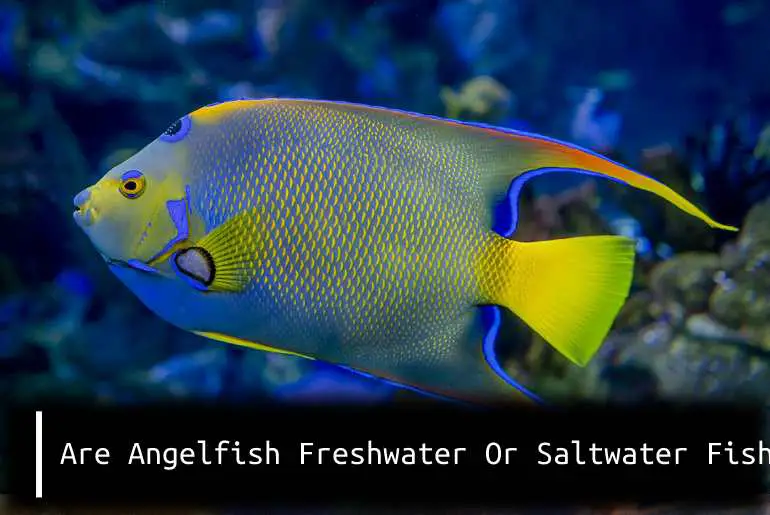Breeding angelfish is a controversial topic among angelfish. Especially amateurs often find it difficult to understand their breeding process. I, too, faced a lot of problems when I first bred them. But now that I know what and how to breed my angels, I also tried cross-breeding them. Have you tried it too? Do you think different species of angelfish can breed?
Yes, you can successfully breed different species of angelfish if you do it right. Furthermore, there even are a lot of inter-mixes in the market now. Different species of angelfish can breed if you have a pair of each species and if these are ready to mate. The female will lay the eggs, and the male will fertilize them. After that, you just need to wait for the fry to hatch and grow up!
That said, not all experts recommend cross-breeding different species of angelfish. And there’s a solid reason why that you will read in this post.
Today, I will talk about my experience breeding different angelfish species. I will also give you some tips on how to do it right. So, if you are planning to breed your own angels, read on!
What Type Of Fish Are Angelfish?
Angelfish are one of the most beautiful fish in the aquarium trade. And you will find them in varieties of colors and patterns. But the most popular ones usually have stripes running vertically along their body. These fish are freshwater fish and are mostly found in South America.
Usually, you will find two types of angelfish, i.e., freshwater and marine. As their name suggests, the freshwater ones are found in rivers and streams, while the marine angelfish are found in saltwater. Also, these fish comes from different families while the freshwater belongs to the cichlids family, and the marine ones come from the Pomacanthidae family.
However, both these fish are equally beautiful and are popular among fish keepers. Although I usually go for freshwater fish, I have kept both kinds at some point in my life. And to be honest, the saltwater angelfish indeed added an extra charm to my aquarium.
What Are The Different Species Of Angelfish?
Angelfish have come a long way; you will know to find them in almost every color imaginable. The most common colors are black, blue, gold, and silver. There are also a wide variety of patterns and shapes.
With a lot of experimentation and all, several hybrid strains have been developed as well. So, you will find a lot of different species of angelfish. However, few of the popular ones in the aquarium trade are
Freshwater Angelfish
These angelfish are popular among beginners as they are easier to take care of. Usually, these fish have a long lifespan and can grow up to six inches. The most common color of freshwater angelfish is silver, with black stripes running vertically along their body.
There are only three types of freshwater angelfish, and these are:
- Pterophyllum Scalare
- Pterophyllum Altum
- Pterophyllum Leopoldi
Saltwater Angelfish
Some aquarists also call these fish marine angelfish. These are difficult to care for and need a lot of attention. Usually, these fish are a little bigger and hardier than their freshwater cousins. So, saltwater angels can grow up to twelve inches and live for around twenty years.
There are usually 86 species of saltwater angelfish. However, some of the popular saltwater angelfish are:
- Queen angelfish
- Emperor angelfish
- Blue Angelfish
- Flame Angelfish
- Coral Beauty Angelfish
- Spotbreast Angelfish
Are Angelfish Livebearers?
Whenever the topic of breeding arises, the first question people ask is, “Are Angelfish livebearers?” The answer to this is no. Angelfish are not livebearers but egg-layers. This means that they will lay eggs, and the male will fertilize them. The eggs will then hatch, and the fry (baby fish) will be born.
And when I say these fish are livebearers, it does apply to both freshwater and saltwater species. Typically, the male will chase the female until she is ready to release her eggs. The female will then lay them on a flat surface, and the male will fertilize the eggs. After a while, the eggs hatch, and there you go- you’ve got baby fish!
Can Different Species Of Angelfish Breed?
Yes, different species of angelfish can breed. In fact, these often do! Angelfish are not particular about their mates and often choose to mate with another angelfish of a different species. This is because angelfish share many similarities with one another, making them compatible for breeding.
Furthermore, there are also various hybrids of angelfish that have been created as a result of breeding different species together. Usually, these hybrids are more colorful and vibrant than either parent species. But, these fish are also generally less hardy and more difficult to care for.
However, while different species of angelfish can breed, the offspring may not be viable. This means that the offspring may not be able to survive or reproduce. Moreover, if you’re interested in breeding angelfish, it’s best to stick to one species. This will increase the chances of success and produce healthy, viable offspring.
But if you want to take the risk and are willing to create an intermixed species of angelfish, go for it! Who knows, you may just create a new and amazing fish. All you need to do is take care of a few things.
What To Consider Before You Breed Different Species Of Angelfish?
As mentioned, interbreeding different species of angelfish is not always a success. So, there are certain things you need to consider before attempting to breed two different species of angelfish. Usually, these include:
Size Of The Tank
The size of the tank is important when you are breeding angelfish. This is because you need a big enough tank to comfortably accommodate all the fish. The last thing you want is your angelfish to fight for space in the tank.
Especially if you keep angelfish of different sizes, the bigger one will bully the smaller one and even kill it. So, make sure you have a big enough tank to breed your angelfish.
Temperament Of The Fish
When you breed different species of angelfish, you need to consider the fish’s temperament. This is because some species of angelfish can be very aggressive, while others are more docile.
If you breed two aggressive species, these fish might fight and kill each other. In addition, the fry born from these fish might also be aggressive. So, it is important to consider the fish’s temperament before breeding them.
Coloration Of The Fish
The fish’s coloration is also important when breeding different angelfish species. This is because some species of angelfish have very bright colors, while others are dull. And you would definitely want a colorful and vibrant fry, right?
So, if you breed two species with different colors, the fry might not have the colors you want. In addition, some color mutations can also occur. So, it is important to consider the fish’s coloration before breeding them. Even if you want to mix the coloration, ensure the fry will still have the colors you want.
Patterns Of Fish
Usually, angelfish are admired for their beautiful patterns. So, when breeding different species of angelfish, you need to consider the patterns of the fish. This is because some species have intricate patterns, while others are simpler.
Always consider the pattern you want the fry to have. In addition, some patterns can be lost when breeding different species. So, if you want to maintain a certain pattern, ensure both species have that pattern.
Probability Of Success
When you breed different species of angelfish, you need to consider the probability of success. This is because some species are difficult to breed, while others are easy.
If you breed two difficult species, the chances of success are very low. In addition, even if you do manage to get the fry, they might not be healthy. Some fry produced after interbreeding is fragile and might not survive for long.
So, while breeding, the probability of producing healthier, stronger, hardier fry must be higher. For this, you need to consider genetic factors as well.
Generic Code
Your angelfish also consists of a generic code, and the traits you want in your angels might be expressed in that code. Usually, there are dominant and recessive genes, and you need to be aware of that.
Moreover, recessive traits are usually only expressed in the fry if both parents carry the gene for that trait. So, if you want your fry to have a certain coloration, ensure both parents carry the gene for that coloration.
Some traits are more recessive than others. So, if you breed two different species of angelfish, the fry might not have the traits you want. In addition, some mutations can also occur. Therefore, it is important to know the generic code before breeding your angelfish.
Considering all these things, you can be sure that you will have a higher chance of success when breeding different species of angelfish.
How To Encourage Breeding Of Angelfish?
Who would not want tiny little fry in their tank? The excitement of seeing a new generation of your chosen fish is hard to beat for many aquarium hobbyists. However, getting to that point isn’t always easy and sometimes requires a little extra work on our part.
Here are some ways that can help encourage breeding:
Provide A Good Diet
A well-fed angelfish is happy, and a happy angelfish is more likely to breed. Moreover, your angelfish requires more energy when spawning, so a good diet is essential to help them through this process. Furthermore, a varied diet of live, frozen, and flake foods will help ensure that your angelfish get all the nutrients your fish need.
Live foods such as brine shrimp, daphnia, or bloodworms are especially good for conditioning breeding stock and encouraging them to spawn. Similarly, frozen foods such as Mysis shrimp or krill are also excellent choices and are often more affordable than live foods.
Some of my suggestions for a good diet for your angelfish are:
- Omega one pellets
- Ocean Nutrition Instant Baby Brine Shrimp 0.7-Ounces (20 Grams) Jar
- Omega One Freeze-Dried Blood Worms, 0.96 oz
- Hikari Bio-Pure Freeze Dried Daphnia for Pets, 0.42-Ounce
- Hikari Tubifex Worms Fish Food (0.7 oz.) [Set of 2]
Maintain Proper Water Conditions
Angelfish are very sensitive to water conditions, and even small changes can stress them out. For this reason, it’s important to keep a close eye on your water parameters and ensure they are within the ideal range for your fish.
Some things you can do to help maintain proper water conditions include:
- Regularly testing your water quality
- performing regular water changes
- using a high-quality filter
- avoiding sudden changes in temperature
Male And Female Ratio
One of the most important things to consider when breeding angelfish is the ratio of males to females. Ideally, you want one male for every two or three females. This ensures that the female fish aren’t overbred and that enough competition among the males to encourage them to mate.
Usually, male angels are territorial and can get aggressive, so it’s important only to keep one male for every two or three females. However, if you have a large tank, you may get away with keeping more males.
Provide Plenty Of Covers
Angelfish feel more secure when there is plenty of cover in their tank. This can be anything from plants to driftwood, rocks, or even caves. Plenty of covers will help your angelfish feel safe and encourage them to breed.
Moreover, proper hiding places can significantly affect fry survival rates. This is because the fry will often hide in these places to avoid being eaten by their parents or other tank mates.
Give Them Some Space
Angelfish need plenty of space to feel comfortable and secure. A good rule of thumb is at least 20 gallons per fish. But, the more space you can provide, the better. I usually go for 55 gallons or more when keeping breeding angelfish.
Another benefit of providing plenty of space is that it can help prevent aggression between your fish. This is especially important when breeding, as aggression can often lead to failed spawnings.
Breeding Angelfish can be a fun and rewarding experience. Following these simple tips can increase your chances of success and result in a tank full of healthy fry.
Do you have any tips for breeding angelfish?
What Are The Examples Of Hybrid Angelfish?
With the evolution of science, people have been able to create new species of animals by crossbreeding two different species. This is called hybridization. For instance, a mule is a hybrid between a donkey and a horse. Similarly, there are various examples of hybrid Angelfish as well. Some of them are:
- Flameback Cherub Angelfish: cross between blue and gold pygmy angelfish
- Hybrid Townsend Angelfish: the cross of blue angelfish and queen angelfish
- Maze Angelfish: cross between blueline angelfish and black velvet angelfish
- Black Velvet Hybrid Angelfish: the cross of blue-spotted angelfish and black velvet angelfish
- Hybrid Clarion Angelfish: clarion angelfish and passer angelfish
- Huge Hybride Emperor Angelfish: cross between emperor angelfish and annularis angelfish
- Pearl Black Angelfish: cross between eibli and Lemon peel
- Tigerpyge Angelfish: a cross between Lemonpeel and eibli
- Lemon peel Hybrid Angelfish: a cross between Lemonpeel and Halfback angelfish
While most of these hybrids are rare and not found in the wild, they are becoming increasingly popular among aquarium hobbyists. This is because hybridization sometimes produces fish with more desirable traits than either parent species. For example, Cherub Angelfish are often prized for their bright colors and patterns.
What Are The Benefits Of Breeding Different Species Of Angelfish?
While most interbreeding between animals of different species is impossible or produces sterile offspring, this is not the case with angelfish. Different species of angelfish can successfully breed and produce fertile offspring. There are several benefits to breeding different species of angelfish.
One benefit is that it can create a more diverse gene pool. This is important because it can help ensure the species’ survival. If all the angelfish in a population are genetically identical, they risk being wiped out by a disease or other threat. But if genetic diversity exists, some individuals may be resistant to the disease and can survive and pass on their genes.
Another benefit of breeding different species of angelfish is that it can produce more colorful and interesting fish. This is often a big selling point for aquarium enthusiasts and can help increase the popularity of the hobby.
A third benefit is that it can help preserve endangered species. If a species of angelfish is in danger of extinction, breeding it with another species can create a hardier hybrid with a better chance of surviving in the wild.
Overall, there are many benefits to breeding different species of angelfish. This is something that aquarium enthusiasts should keep in mind when setting up their tanks.
What Are The Drawbacks Of Breeding Different Species Of Angelfish?
Different species of angelfish can certainly breed, but there are a few potential drawbacks to consider.
- For one, the offspring may not be as hardy as those from parents of the same species.
- It can weaken the gene pool and lead to inbreeding and genetic defects.
- Additionally, different species of angelfish often have different care requirements, so it can be difficult to provide the proper environment for all fish.
- Finally, different species of angelfish may have different aggression levels, which can lead to problems when housed together.
Can I Keep Different Species Of Angelfish Together?
Different species of angelfish can indeed coexist together in the same aquarium. However, it is important to keep a few things in mind. First, different species of angelfish can have different temperaments and aggression levels. Some species are more peaceful, while others can be quite nippy and aggressive. It is important to do your research and choose angelfish that will be compatible with each other.
Another thing to keep in mind is that different species of angelfish can have different dietary needs. Some angelfish are herbivores, while others are omnivores or even carnivores. Be sure to research the diet of the different species of angelfish you are considering keeping together and make sure they will all be able to thrive on the same diet.
Last, but not least, different species of angelfish can have different spawning behaviors. Some angelfish are mouthbrooders, while others lay their eggs on the substrate. If you are planning on breeding your angelfish, it is important to choose species that will be compatible in this regard as well.
Keeping different species of angelfish together can be a fun and rewarding experience. Just be sure to do your research and ensure you are prepared to meet the needs of all your fish!
Conclusion
In conclusion, different species of angelfish can most definitely breed with each other – and successfully produce fry. However, it is important to remember that when you are mixing different species together, you may not have the results you were expecting. Make sure that you research before purchasing any fish so that you know what to expect in terms of appearance, temperament, and care requirements. Thanks for reading!
I hope that you have found this article interesting and informative. If you have any questions or comments, please feel free to leave them below. Until next time, happy fishkeeping!






